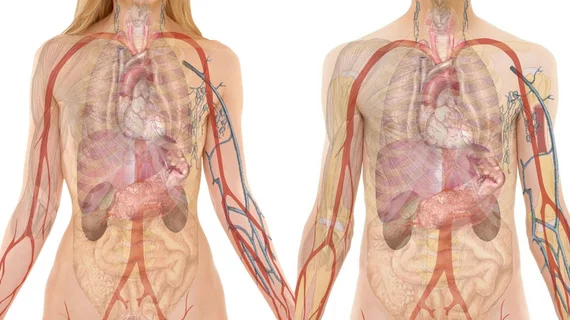Preclinical med students quick studies in cardiac POCUS
Briefly trained in point-of-care cardiac ultrasound, 72% of second-year medical students obtained clinical-quality views from a mannequin and 61% made the correct diagnosis in a volunteer simulated patient.
The imaging target was a pericardial effusion, the diagnosis was cardiac tamponade, and the volunteer “patient” had a preexisting condition—low blood pressure.
The project was carried out at Indiana University School of Medicine and is described in a study report published this summer in Cureus [1].
Prior to training the 132-member class in cardiac POCUS, emergency medicine specialist Frances Russell, MD, and colleagues assessed the students’ prior knowledge of the technology with several test questions.
Nearly all, 95%, had little to no previous POCUS experience.
Next the researchers presented the clinical novices with a short video on cardiac ultrasound technique, anatomy and pathology. This they followed with a 10-minute session of hands-on, one-to-one instruction involving the patient and the POCUS machine.
Splitting into 57 groups of two to four, the students then completed a case simulation. This entailed acquiring a parasternal long axis (PSLA) cardiac ultrasound view, identifying the sickness and making a diagnosis.
Along with the 72% and 61% results above, Russell and co-authors found students’ ability to identify a pericardial effusion on a PSLA view rose from 46% pre-training to 69% post.
In their discussion the authors underscore that 28% of the field failed to obtain a clinically adequate image and nearly 40% did not correctly name cardiac tamponade as the condition.
There are multiple explanations for why some students stumbled at image acquisition as well as interpretation, they suggest.
The amount of time and instruction needed to learn how to acquire images for a cardiac ultrasound exam may vary, they allow, adding that cardiac POCUS is one of the harder POCUS scans to master. More:
While there are limited proficiency studies assessing cardiac ultrasound, there are society guidelines through the American College of Emergency Physicians recommending at least 25 to 50 examinations be performed to attain proficiency in transthoracic cardiac ultrasound. … [Additionally], pre-clinical students have not had exposure to pathology, including patients with hypotension and cardiac tamponade, outside of the classroom setting, which likely had an impact on their ability to recognize this diagnosis in a clinical scenario.”

